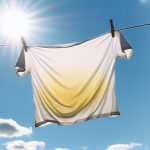Are you tired of separating your laundry into whites and colors? Do you dread the extra time and effort it takes to ensure your clothes don’t bleed onto each other in the wash? The question on your mind may be: can you dry whites and colors together?
While it may seem like a time-saving solution, there are risks involved in mixing your laundry loads. First and foremost, there is the possibility of color bleeding. If a colored garment releases dye in the dryer, it can stain your white clothes. Additionally, some fabrics may not dry at the same rate, resulting in uneven dryness or damage to delicate materials.
But, on the other hand, there may be benefits to drying whites and colors together, such as saving energy and reducing your carbon footprint. Before you make a decision, it’s important to consider all the factors and take precautions to protect your clothes.
Table of Contents
The Risks of Drying Whites and Colors Together
Don’t make this laundry mistake – drying whites and colors together can lead to disastrous results! Mixing whites and colors in the dryer is a risky move that can ruin your clothes.
The colors can bleed onto the whites, leaving them stained and discolored. This is especially problematic if you have delicate fabrics or clothes that are prone to bleeding.
Even if you don’t notice any immediate damage, drying whites and colors together can lead to long-term problems. Over time, the colors can fade and the whites can become dingy. This can make your clothes look old and worn out much faster than they should.
It’s important to keep your whites and colors separate to ensure that they stay looking fresh and new for as long as possible. When it comes to doing laundry, taking a little extra time to sort your clothes can save you a lot of hassle in the long run.
So, the next time you’re tempted to toss your whites and colors together in the dryer, resist the urge and take the time to separate them. Your clothes will thank you!
The Benefits of Drying Whites and Colors Together
Did you know that drying your whites and colors together could actually be beneficial? It’s not only time-saving, but also energy-efficient since you’re running the dryer less frequently. Plus, it’s just plain convenient to throw everything in together instead of separating loads.
Adjusting the paragraph structure in this way allows complete thoughts to be logically grouped on their own lines, making the information easier to read and understand. It also creates natural breaks between ideas, emphasizing their importance and helping the reader to absorb the information more effectively.
Time-Saving
By drying whites and colors together, you’ll save precious time and have more free time to do what you love. Rather than separating your laundry and running multiple loads, you can simply toss everything into the dryer at once.
This means less time spent sorting and more time spent doing other things. Plus, you won’t have to wait as long for your laundry to be ready. Instead of waiting for one load to finish before starting another, you can run everything together and have it all done at once.
This is especially convenient if you have a busy schedule and don’t have the time to wait around for laundry to finish. So why not give it a try and see how much time you can save?
Energy-Efficient
Saving energy is important for both the environment and your wallet, and drying your laundry together in one load can be a more energy-efficient option. When you separate your whites and colors, you end up running two separate loads in your dryer, which doubles the energy usage. By combining both loads, you reduce the number of loads you run, which saves both time and energy.
In addition, drying your laundry on a lower heat setting can also save energy. Most fabrics can be dried on a low or medium heat setting, which uses less energy than a high heat setting. By taking the time to sort your laundry and dry it on a lower heat setting, you can reduce your energy usage and save money on your energy bills. Not only is this better for the environment, but it’s also a more cost-effective way to do your laundry.
Convenient
It’s so much more convenient to dry your laundry in one load! No more separating whites and colors or worrying about accidentally ruining your favorite shirt.
Here are some reasons why drying whites and colors together can be a time-saver and simplify your laundry routine:
-
Saves time: No need to wait for two separate loads to finish drying. You can get all your laundry done in one go.
-
Reduces energy consumption: Drying one load instead of two saves energy and reduces your carbon footprint.
-
Less sorting: With just one load, you won’t have to spend time sorting your laundry.
-
Easier storage: When all your laundry is in one load, it’s easier to put everything away at once. No more trying to remember where you put that one missing sock from a different load.
Overall, drying whites and colors together can make your laundry routine more convenient and efficient. Give it a try and see how it can simplify your life.
Factors to Consider Before Drying Whites and Colors Together
Before you toss your whites and colors in the dryer together, consider these important factors.
First, check the care label on each garment. Some fabrics, such as wool or silk, are more delicate and should be washed and dried separately. If a garment has a label that says ‘wash separately’ or ‘dry clean only,’ it’s best to follow those instructions to prevent damage.
Second, consider the colorfastness of your clothes. If you’re unsure whether a garment will bleed or fade, it’s better to err on the side of caution and wash it separately. You don’t want to end up with a pink shirt that used to be white! To test colorfastness, dampen a small area of the garment and rub it with a white cloth. If any color transfers, it’s best to wash the garment separately.
Think about the risk of shrinkage. Some fabrics, such as cotton, can shrink in the dryer. To minimize this risk, wash in cold water and dry on a low heat setting. If you’re drying whites and colors together, make sure all garments are similar in size and made from similar fabrics. This will help prevent uneven drying and potential shrinkage.
By taking these factors into account, you can prevent damage to your clothes and keep them looking their best.
Tips for Drying Whites and Colors Together
When it comes to drying whites and colors together, there are a few key points to keep in mind. First, try using color catchers to prevent bleeding.
Second, always wash your clothes in cold water to help preserve the colors.
Third, sort your clothes by fabric type to avoid damage.
Lastly, use a low heat setting to prevent shrinkage and damage to the fabrics.
By following these tips, you can successfully dry your whites and colors together without any mishaps.
Use Color Catchers
To prevent colors from bleeding in the wash, try using color catchers. These nifty little sheets are designed to absorb any loose dyes that may be floating around in the wash water, preventing them from staining other clothes in the load.
Simply toss a color catcher sheet into the washing machine along with your whites and colored items and let it work its magic. Color catchers are especially helpful when washing new or brightly colored clothing items that may still be releasing dye. They are also a great option for those who prefer to do laundry less frequently, as they allow you to wash larger loads without worrying about color bleeding.
So next time you’re wondering if you can dry whites and colors together, remember to use color catchers for a worry-free laundry experience.
Wash Clothes in Cold Water
Did you know that washing your clothes in cold water can save you money on your energy bill and help your clothes last longer? It’s true!
Cold water is just as effective at cleaning your clothes as hot water, but it uses less energy and is gentler on your fabrics. Plus, it can help prevent color bleeding and shrinking, which is especially important if you’re washing whites and colors together.
When you wash your clothes in cold water, you’re also doing your part to reduce your environmental impact. Hot water uses more energy to heat up, which means it produces more greenhouse gas emissions.
By washing in cold water, you’re using less energy and reducing your carbon footprint.
So, the next time you’re doing laundry, consider washing your clothes in cold water to save money, prolong the life of your clothes, and help the planet.
Sort Clothes by Fabric Type
Sorting clothes by fabric type can be beneficial for both the longevity of your clothes and the effectiveness of your laundry routine. Here are some tips to help you sort your clothes by fabric type:
-
Separate delicate fabrics, such as silk and lace, from heavy fabrics like denim and towels.
-
Sort clothes by color to prevent bleeding, but also consider separating bright colors from pastels and whites to avoid color transfer.
-
Group clothes with similar care instructions together, such as those that require gentle cycles or air-drying.
-
When in doubt, check the care label on your clothes for specific washing instructions and sort accordingly.
By taking the time to sort your clothes by fabric type, you can avoid damaging delicate fabrics and ensure that your clothes remain in good condition for longer. Additionally, sorting clothes by care instructions can make your laundry routine more efficient and effective, saving you time and money in the long run.
Use a Low Heat Setting
Using a low heat setting on your dryer can be crucial in preserving the quality and longevity of your clothes. When you mix whites and colors in the dryer, it’s important to set the temperature to a low setting to avoid color bleeding.
High heat can cause the dye from colored clothes to transfer onto white fabrics, resulting in unsightly stains that are difficult to remove. Additionally, high heat can also cause shrinkage and damage to delicate fabrics.
To prevent this, always check the care labels on your clothes to ensure you’re using the appropriate heat setting. When in doubt, it’s always best to err on the side of caution and use a low heat setting.
By doing so, you’ll extend the life of your clothes and save money in the long run by avoiding premature wear and tear.
Alternatives to Drying Whites and Colors Together
One option is to hang your whites and colors on separate clothing lines, like a colorful rainbow and a bright white cloud floating in the breeze. This allows your clothes to dry naturally without risking any color bleeding or discoloration.
If you don’t have access to separate clothing lines, you can use hangers or drying racks to keep your whites and colors separate. Another alternative is to use a clothes dryer with a drying rack or separate compartments for whites and colors. This allows you to dry your clothes together without worrying about any color bleeding. Just make sure to follow the instructions on the drying rack or compartments to ensure that your clothes are drying properly and without damage.
If none of these options are available to you, try washing your whites and colors separately to prevent any color bleeding during the drying process. This may take a bit more time and effort, but it can keep your clothes looking bright and fresh for longer.
In the end, it’s up to you to decide what works best for your laundry routine and preferences.
Common Myths About Drying Whites and Colors Together
You may have heard that drying whites and colors together is a big no-no. But what are the common myths surrounding this laundry practice?
First, there’s the myth that all colors bleed, which can lead you to separate every piece of clothing you own.
Then, there’s the myth that only dark colors bleed, making you think it’s okay to mix lighter shades.
Finally, there’s the myth that drying whites and colors together always leads to fading, leaving you worried about ruining your favorite clothes.
Let’s debunk these myths and find out the truth about drying whites and colors together.
Myth: All Colors Bleed
Don’t believe the myth that all colors bleed when drying them together, it’s simply not true. While it’s true that some colors may bleed, it’s not a guarantee for all of them. It all depends on the type of fabric and the quality of the dye used.
In fact, many modern fabrics are designed to be colorfast, meaning they won’t bleed or fade even after multiple washes and drying cycles.
If you’re still worried about colors bleeding, there are a few things you can do to minimize the risk. First, always separate your whites and darks to minimize the chance of any color transfer. You can also use color-catching sheets or detergents that are specifically designed to trap any loose dyes in the wash. And finally, if you’re really concerned about a particular item bleeding, consider air-drying it instead of putting it in the dryer.
But overall, don’t let the myth of all colors bleeding stop you from drying your whites and colors together – just be mindful and take a few precautions to ensure your clothes stay looking their best.
Myth: Only Dark Colors Bleed
You might think that only dark colors bleed, but that’s just another myth to bust when it comes to laundry. In fact, all colors have the potential to bleed when washed together. However, there are steps you can take to minimize the risk of color bleeding and keep your whites and colors looking their best.
One of the most important things you can do is to sort your laundry properly. This means separating your whites, darks, and colors into different piles before you start washing. But what about when it comes time to dry your clothes? Can you dry whites and colors together? Let’s take a closer look at the facts and explore some tips for drying your laundry safely and effectively.
| Pros of Drying Whites and Colors Together | Cons of Drying Whites and Colors Together |
|---|---|
| Saves time and energy | Colors may bleed onto whites |
| Less laundry to fold and put away | Whites may become discolored |
| Can be convenient for small loads | Clothes may not dry evenly |
| Tips for Drying Whites and Colors Together |
|---|
| Use a low heat setting to prevent damage to delicate fabrics |
| Remove clothes from the dryer as soon as they are dry to prevent wrinkles and reduce the risk of color bleeding |
| Avoid overloading the dryer, which can lead to uneven drying and increase the risk of color bleeding |
| Consider using a color-catching sheet or detergent to help prevent color bleeding |
By following these tips and being mindful of the risks, you can successfully dry your whites and colors together without sacrificing the quality of your laundry. Remember, it’s always better to err on the side of caution and take the extra time to sort your laundry properly if you’re unsure about how certain fabrics will react to being washed and dried together.
Myth: Drying Whites and Colors Together Always Leads to Fading
Contrary to popular belief, drying your laundry in the same load doesn’t always result in faded clothes. In fact, there are several factors that determine whether or not your clothes will fade in the dryer. Here are some things to consider:
-
Fabric type: Some fabrics are more prone to fading than others. For example, cotton and linen are more likely to fade than synthetic materials like polyester.
-
Detergent: The type of detergent you use can also affect the color of your clothes. Some detergents contain harsh chemicals that can cause fading, while others are formulated to be gentler on fabrics.
-
Temperature: The higher the temperature of your dryer, the more likely your clothes are to fade. If you’re concerned about fading, try using a lower temperature setting.
By taking these factors into account, you can minimize the risk of fading and keep your clothes looking bright and vibrant for longer.
So don’t be afraid to mix your whites and colors in the dryer – just be sure to follow these tips to keep your clothes looking their best.
- What Does Organza Feel Like? - April 23, 2024
- What Is the Difference Between Organza and Organza Silk? - April 23, 2024
- What Are the Pros and Cons of Organza Fabric? - April 23, 2024







